Discover the most effective methods to eradicate mold from your window sills, ensuring a cleaner and healthier living environment for you and your family.
Welcome to my latest blog post where we will be discussing one of the most common issues that homeowners face – mold on window sills. Not only is it unsightly, but it can also cause health problems if left untreated.
But don’t worry, with the right tools and techniques, you can easily remove mold from your window sills and prevent it from coming back. In this post, I’ll be sharing some tips on how to clean mold off window sills effectively and safely.
So grab a cup of coffee and let’s dive in!
Key takeaways:
- Identify the type of mold on your window sills
- Moisture buildup from condensation is the main cause of mold
- Protect yourself with gloves, a mask, goggles, and good ventilation
- Use the right cleaning supplies, including vinegar and baking soda
- Seal gaps, maintain good ventilation, and clean regularly to prevent future mold growth
Identifying Mold Types
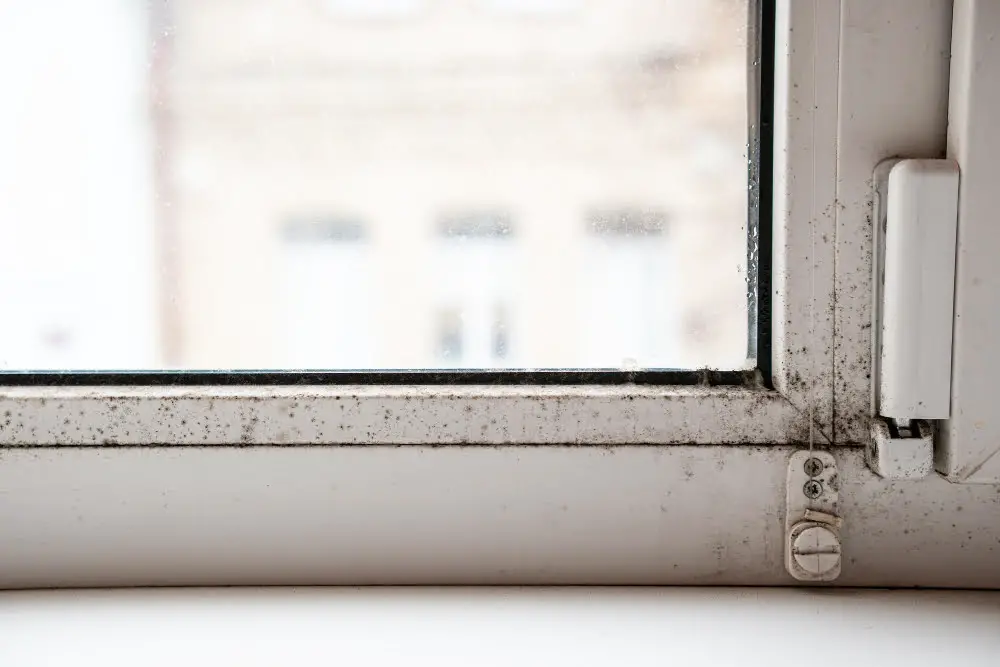
Before you start cleaning mold off your window sills, it’s important to identify the type of mold you’re dealing with. There are many different types of molds, and some can be more harmful than others.
The most common types of molds found on window sills include Aspergillus, Cladosporium, Penicillium and Stachybotrys chartarum (also known as black mold).
Aspergillus is a very common type of indoor mold that can appear in various colors such as green or yellow. It usually grows on damp surfaces like walls or ceilings but can also grow on windowsills.
Cladosporium is another common indoor mold that appears dark green to black in color. It thrives in areas with high humidity levels such as bathrooms and kitchens.
Penicillium is a blue-green colored fungus commonly found growing on decaying organic materials like food items or wallpaper glue.
Stachybotrys chartarum (black mold) has become infamous for its potential health hazards due to mycotoxins produced by this species when it grows indoors under certain conditions.
Causes of Mold On Window Sills
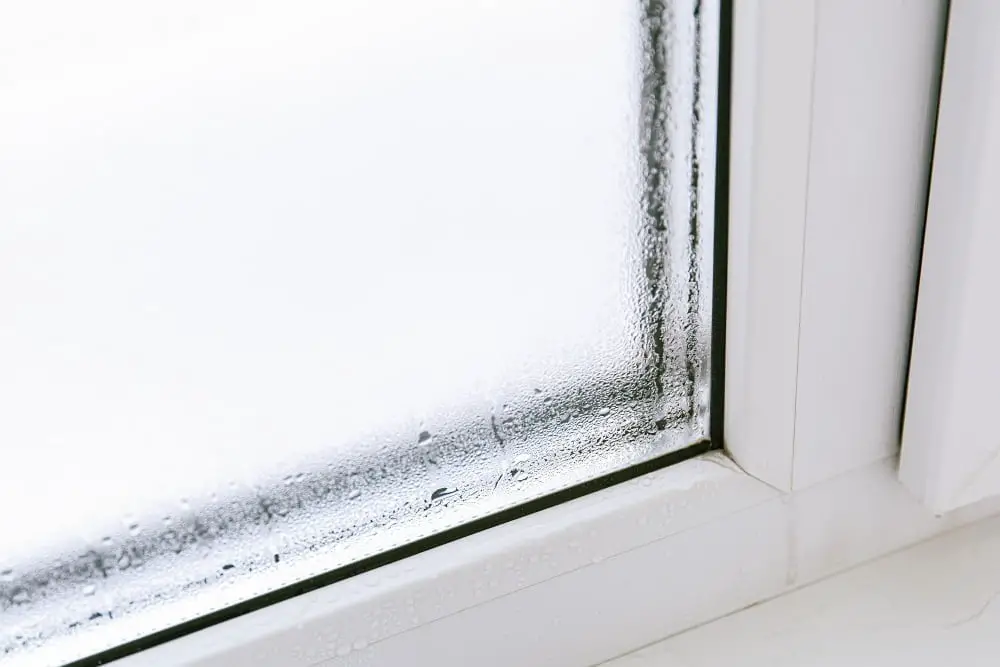
It can grow on any surface, including window sills. The most common cause of mold growth on window sills is moisture buildup due to condensation.
When warm air meets the cold glass surface, it creates condensation which can accumulate over time and create an ideal environment for mold growth.
Other causes include water leaks from damaged or poorly sealed windows, high humidity levels in the home, lack of ventilation or poor airflow around windows, and dirty surfaces that provide a breeding ground for mold spores.
It’s important to identify the root cause of your mold problem so you can take appropriate measures to prevent its recurrence after cleaning it off your window sill.
Safety Precautions

Mold can cause health problems such as allergies, respiratory issues, and skin irritation. Therefore, you must protect yourself while removing mold from your window sills.
Firstly, wear protective gear such as gloves and a mask to avoid direct contact with mold spores. You should also wear goggles to prevent any splashes of cleaning solution or debris from getting into your eyes.
Secondly, ensure that the room is well-ventilated by opening windows or using fans during the cleaning process. This will help reduce exposure to airborne mold spores.
Lastly, keep children and pets away from the area being cleaned until it’s completely dry after finishing up with all necessary steps in removing molds on window sills.
Protective Gear for Cleaning
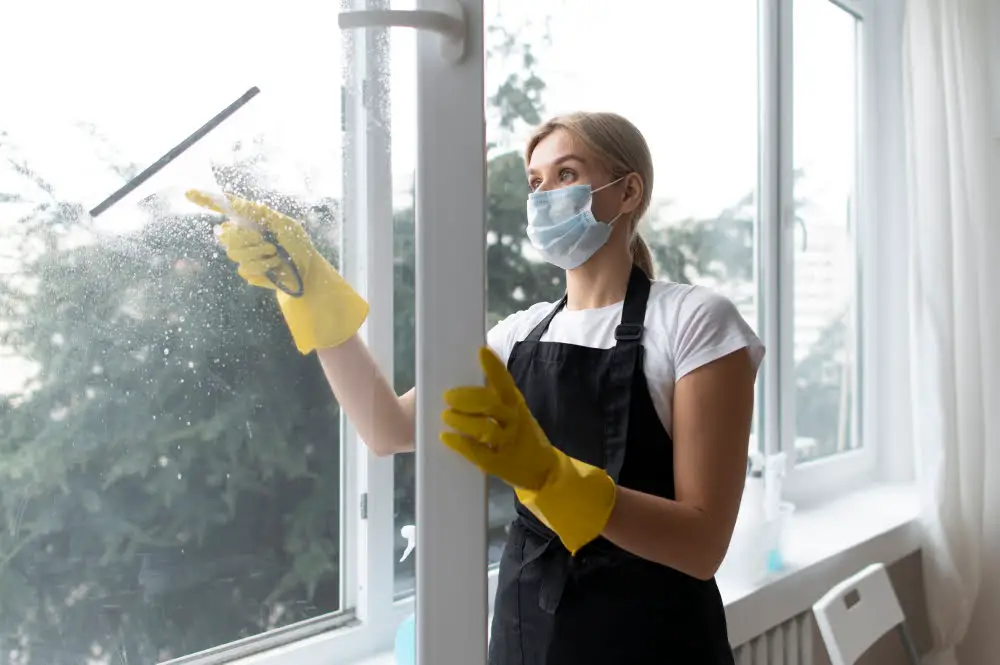
Mold spores can cause respiratory problems and allergic reactions, so it’s essential to protect yourself from exposure. Here are some protective gear items that you should consider wearing:
1. Gloves: Wear gloves made of rubber or latex to avoid direct contact with the mold.
2. Respirator mask: A respirator mask will prevent inhalation of airborne mold spores while cleaning.
3. Goggles: Protect your eyes from splashes by wearing goggles or other eye protection.
4. Long-sleeved shirt and pants: Cover as much skin as possible with long-sleeved shirts and pants to minimize skin exposure.
5. Shoe covers/booties – Put on shoe covers before entering the area where there is a presence of molds.
Gather Cleaning Supplies
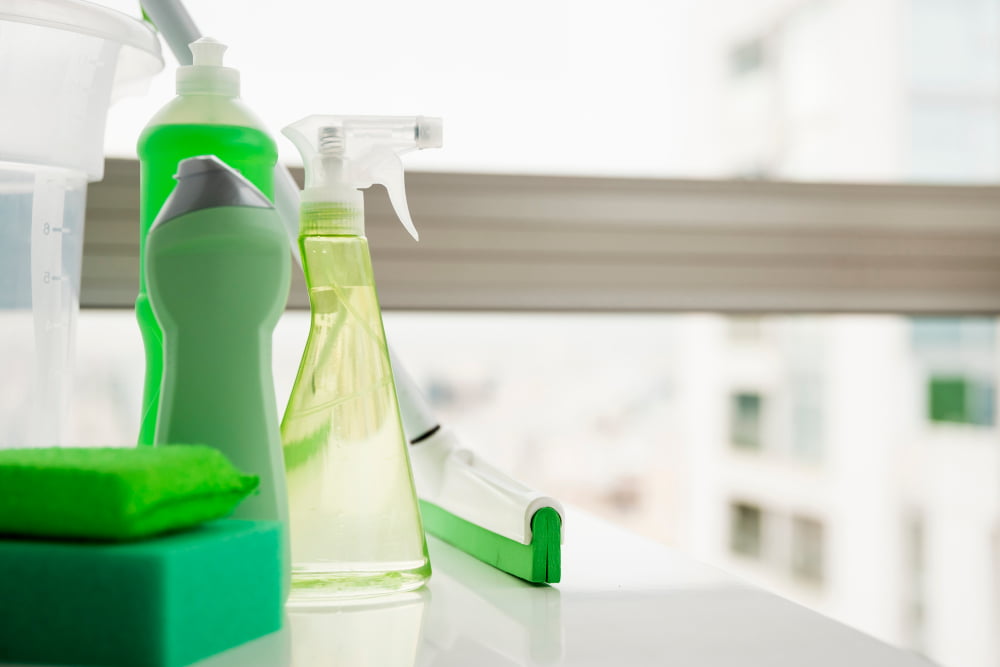
This will save you time and ensure that the job is done effectively. Here are some of the items you’ll need:
1. Gloves: Wear rubber gloves to protect your hands from coming into contact with mold spores.
2. Face Mask: A face mask or respirator will prevent inhalation of airborne mold spores.
3. Safety Goggles: Protect your eyes from splashes by wearing safety goggles.
4. Stiff Brush: Use a stiff-bristled brush for scrubbing away stubborn mold stains on window sills.
5. Cleaning Solution: You can use commercial cleaning products specifically designed for removing molds or make natural solutions using vinegar, baking soda, hydrogen peroxide etc.
6. Water and Cloth: Keep a bucket filled with water and clean cloth handy while working on windowsill so that after applying solution, you can rinse it properly.
Cleaning Products for Mold
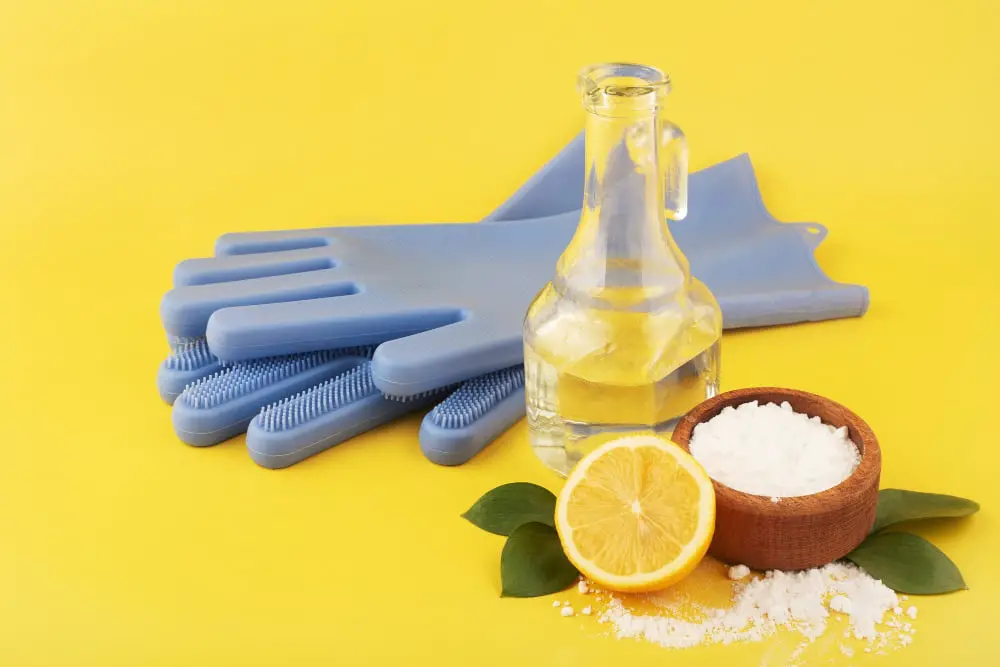
However, not all cleaning products are created equal. Some may contain harsh chemicals that can be harmful to your health and damage your windows.
It’s important to choose a product specifically designed for removing mold from surfaces like window sills. Look for a cleaner with active ingredients such as hydrogen peroxide or sodium hypochlorite (bleach).
These ingredients have been proven effective against various types of molds.
If you prefer natural alternatives, vinegar and baking soda solutions work well too. Mix one part white vinegar with one part water in a spray bottle and apply it directly on the affected area.
Let it sit for 10-15 minutes before scrubbing with a stiff brush and rinsing thoroughly.
Natural Mold Removal Methods
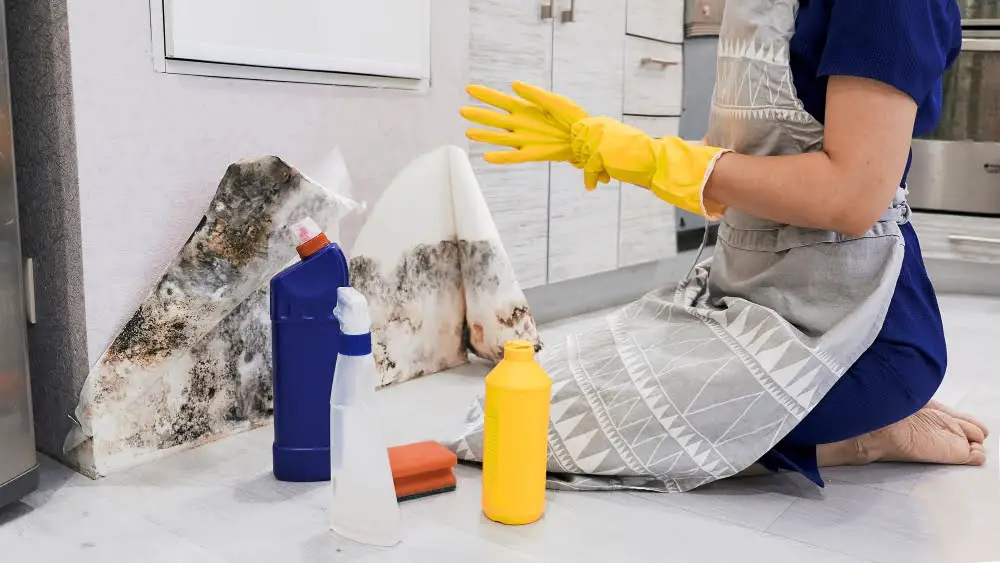
One of the most effective is white vinegar. Simply mix equal parts water and vinegar in a spray bottle and apply it to the affected area.
Let it sit for about an hour before scrubbing with a stiff brush and wiping clean.
Another natural option is tea tree oil, which has antifungal properties that can kill mold spores on contact. Mix one teaspoon of tea tree oil with one cup of water in a spray bottle and shake well before applying to the affected area.
Baking soda is also an effective natural cleaner that can remove mold from window sills without harsh chemicals or fumes. Mix two tablespoons of baking soda with one cup of water until dissolved, then apply to the affected area using a sponge or cloth.
Vacuum Loose Mold Spores
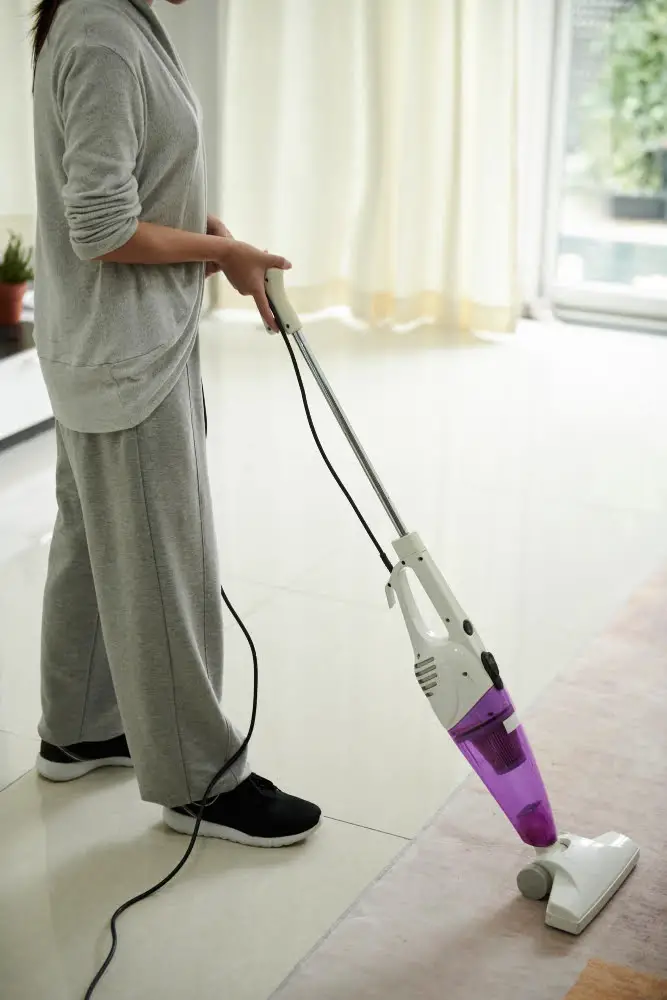
This will help prevent them from spreading to other areas of your home during the cleaning process.
Using a HEPA filter vacuum cleaner, start by gently removing any visible mold growth with a soft brush attachment. Be sure to dispose of the contaminated materials in a sealed plastic bag immediately after use.
Next, switch to using a crevice tool attachment for hard-to-reach areas such as corners or gaps between windows and sills. Make sure you cover all surfaces thoroughly before moving on to applying your chosen mold removal solution.
Remember that vacuuming alone won’t completely remove all traces of mold spores but it’s an essential first step in preparing for effective cleaning.
Apply Mold Removal Solution
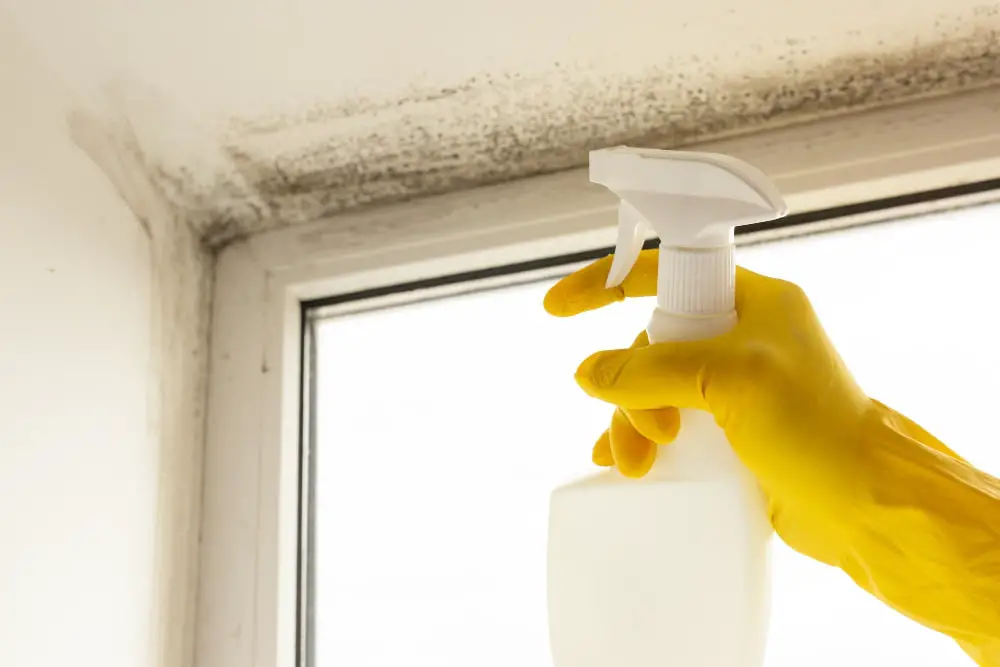
There are several commercial products available in the market that can effectively remove mold from window sills. However, if you prefer natural alternatives, vinegar and hydrogen peroxide are excellent options.
To use a commercial product or vinegar for removing mold from window sills:.
- Follow the instructions on the label of your chosen product.
- Apply an ample amount of solution onto the affected area using a spray bottle or sponge.
- Let it sit for 10-15 minutes to allow penetration into porous surfaces like wood and drywall.
- Scrub with a stiff brush until all visible signs of mold have been removed.
If you’re using hydrogen peroxide:.
- Mix equal parts water and 3% hydrogen peroxide in a spray bottle
- Spray generously over affected areas
- Let sit for at least ten minutes before scrubbing away
Remember always to wear protective gear when handling any cleaning solutions as they may cause skin irritation or respiratory problems if not handled correctly.
Scrub With a Stiff Brush
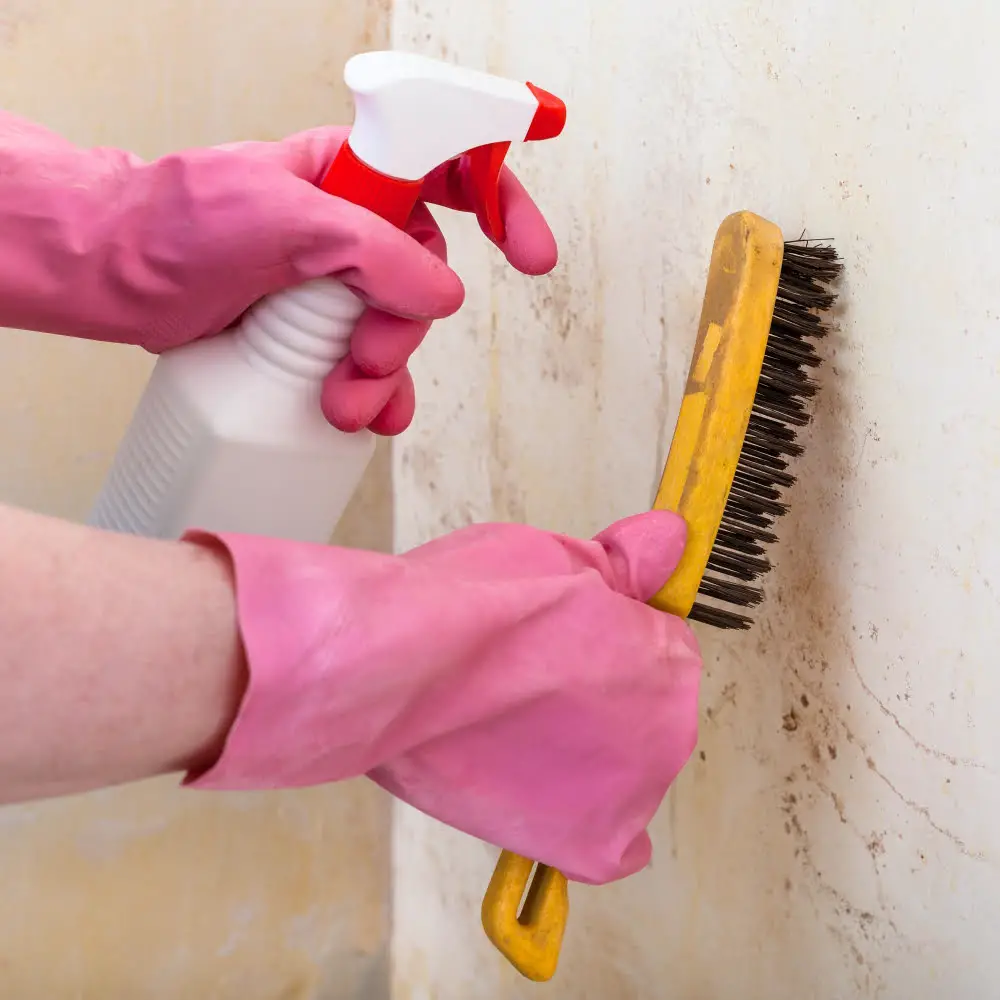
This will help remove any remaining mold and ensure that your window sill is thoroughly cleaned. Be sure to use a brush with firm bristles, as this will make it easier to remove stubborn mold stains.
When scrubbing, start from one end of the window sill and work your way towards the other end in small sections. Apply enough pressure on the brush while ensuring not to damage or scratch your windowsill surface.
It’s important not to rush through this process as thorough cleaning is essential for preventing future growth of molds on your windowsills. Once you’ve finished scrubbing each section, wipe away any excess moisture using a clean cloth before moving onto another area.
Wipe and Rinse Thoroughly
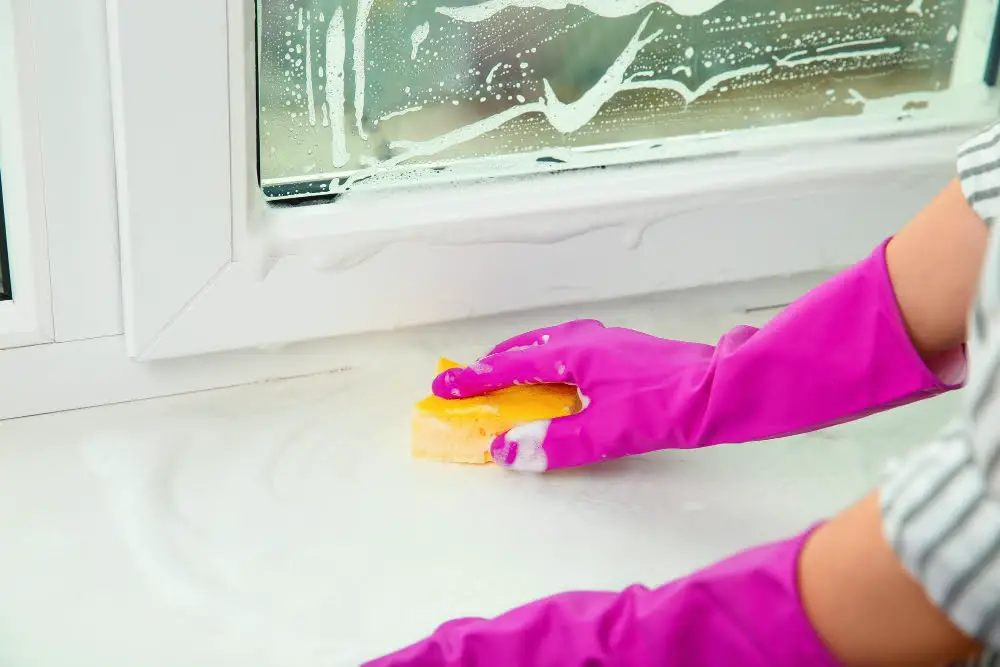
Use a clean cloth or sponge to wipe away any remaining mold residue and cleaning solution. Be sure to rinse the cloth or sponge frequently in clean water as you work your way across the window sill.
Once you’ve wiped away all of the mold, use another clean cloth or paper towel to dry off the surface completely. Leaving moisture on your windowsill can encourage future mold growth.
It’s important not to rush this step – thorough wiping and rinsing will ensure that all traces of mold are removed from your window sills. Take extra care around corners, edges, and other hard-to-reach areas where moisture tends to accumulate.
Dry the Window Sill
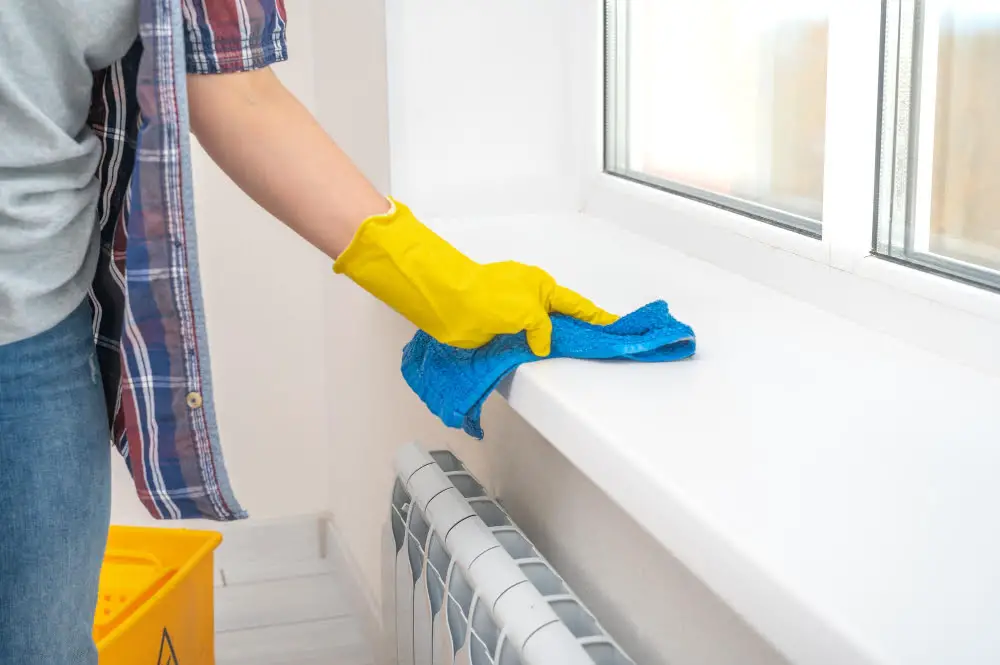
Leaving any moisture behind can encourage mold growth and undo all your hard work. Use a clean towel or rag to wipe away excess water from the surface of the window sill.
If necessary, use a hairdryer on low heat setting to ensure that every nook and cranny is completely dry.
It’s also essential that you keep an eye on your windowsill for several days after cleaning it for any signs of returning mold growth. If you notice any new spots forming, repeat the process again until they are gone.
By following these simple steps, not only will you be able to remove mold from your window sills effectively but also prevent its recurrence in future.
Preventing Future Mold

Here are some tips on how to keep your windows and home free of mold:.
1. Maintain good ventilation: Proper air circulation is essential in preventing moisture buildup, which can lead to mold growth.
Open windows and doors when possible or use exhaust fans in bathrooms and kitchens.
2. Dehumidify your home: High humidity levels create a breeding ground for mold spores, so investing in a dehumidifier can help reduce moisture levels.
3. Establish a regular cleaning schedule: Regularly cleaning surfaces like window sills with soap and water will remove any potential food sources for molds such as dirt or dust particles.
- Seal gaps & cracks: Check around the edges of windows for gaps where air may be entering into the house causing condensation on cold surfaces like glass panes leading up-to mould formation.
- Inspect for water leaks: Inspect pipes regularly especially those running through walls, ceilings etc., check if there are any signs of leakage as this could cause dampness leading up-to mould formation.
Preventing Mold Buildup On Windows
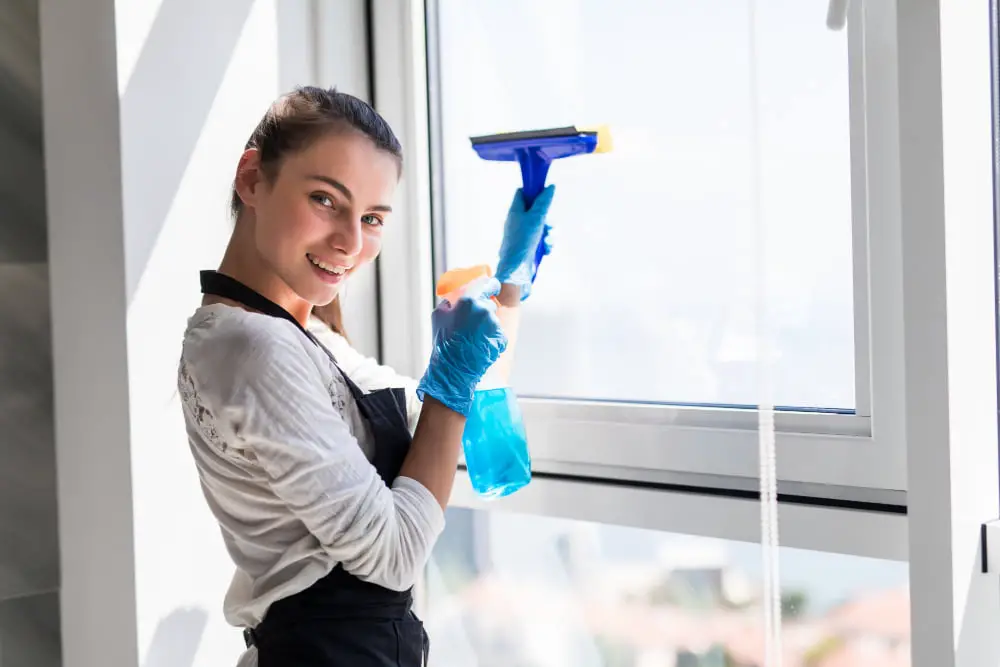
One of the best ways to do this is by preventing mold buildup on your windows in the first place.
Maintaining good ventilation is key. Make sure your windows are properly sealed and open them regularly, especially during humid weather or after taking a shower or cooking.
This will help reduce moisture levels in your home and prevent condensation from forming on the glass.
Another effective way of preventing mold buildup is by dehumidifying your home using a dehumidifier machine or air conditioning unit with built-in humidity control features.
It’s also essential to establish a regular cleaning schedule for all areas prone to moisture accumulation, including window sills. By keeping surfaces dry and free of dust and debris, you can significantly reduce the chances of mold growth.
Inspecting for water leaks around windows should be part of routine maintenance checks as they can cause significant damage if left unaddressed over time.
Maintain Good Ventilation

Proper air circulation helps to reduce moisture levels, which are a breeding ground for mold spores.
To improve ventilation, you can open windows and doors regularly or use exhaust fans in areas prone to moisture buildup such as bathrooms and kitchens. You can also invest in a dehumidifier that will help regulate humidity levels throughout your home.
By keeping the air moving and reducing excess moisture, you’ll be able to create an environment that’s less conducive for mold growth on window sills. This simple step can go a long way towards preventing future outbreaks of this pesky problem.
In addition to improving ventilation, there are other preventative measures you should take such as regular cleaning schedules and sealing gaps around windows where water may seep through during rainstorms or snowmelt.
Dehumidify Your Home

To prevent this, it’s important to keep the humidity levels in check. A dehumidifier can help you achieve this by removing excess moisture from the air.
If you live in a humid climate or have noticed condensation on your windows, investing in a dehumidifier may be necessary. You can purchase one at most home improvement stores or online retailers.
When using a dehumidifier, make sure to follow the manufacturer’s instructions for optimal use and maintenance. Emptying and cleaning out its water tank regularly will ensure that it continues to function properly.
Regular Cleaning Schedule
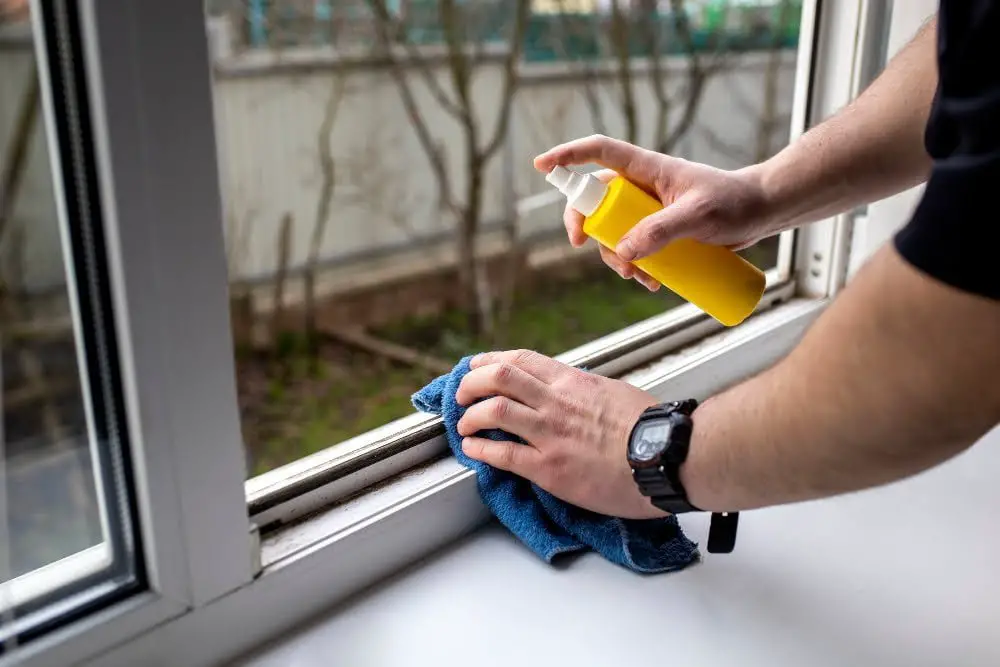
Mold thrives in damp and humid environments, so make sure to keep your windows dry and well-ventilated. Wipe down the window sills with a microfiber cloth or paper towel at least once a week.
If you live in an area with high humidity levels, consider using a dehumidifier or air conditioner to reduce moisture levels inside your home.
Inspect for any water leaks around the windows regularly as they can cause mold growth if left unattended. Seal any gaps or cracks around the windows where water may seep through.
Seal Gaps and Cracks
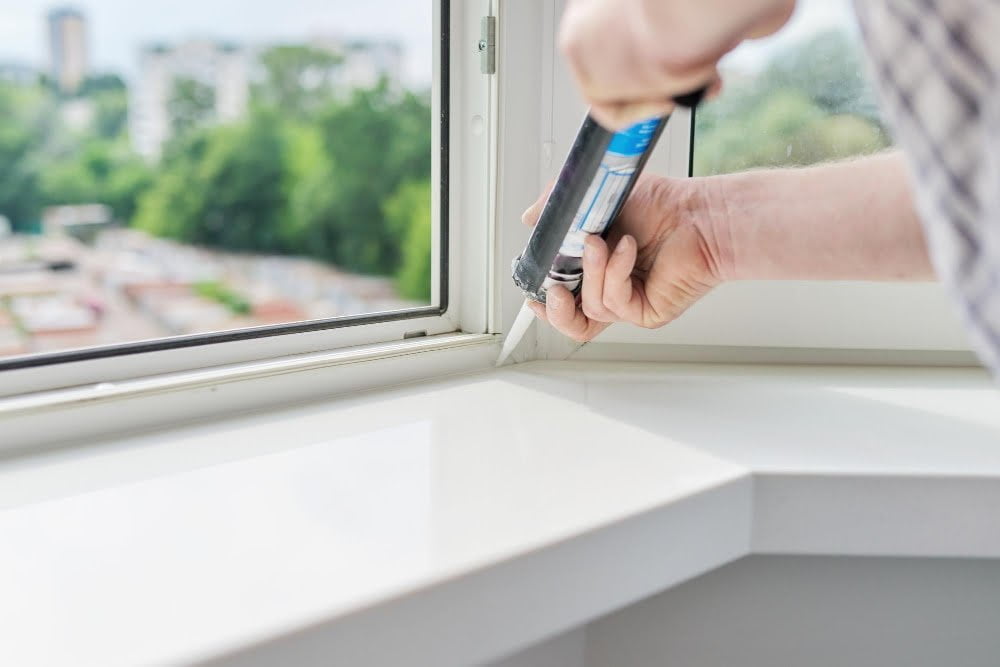
These openings allow water to seep in, creating a damp environment that promotes mold growth. To prevent this from happening, it’s essential to seal any gaps or cracks around your windows.
You can use caulking or weatherstripping to seal these areas effectively. Caulk is ideal for sealing larger gaps and holes, while weatherstripping works best for smaller ones.
Make sure you choose a high-quality product that will last long without cracking or peeling.
To apply caulk, clean the area thoroughly with soap and water before applying it evenly along the gap using a caulking gun. Smooth out any excess caulk with your finger or a putty knife.
For weatherstripping, measure the length needed for each gap before cutting strips accordingly using scissors or utility knives then press them into place firmly against both sides of each opening until they stick securely in place.
Inspect for Water Leaks

If you notice that your window sill has mold growth, it’s important to inspect the area around it for any signs of water damage or leaks. Check if there are any cracks in the windowsill or gaps between the wall and frame where moisture can seep through.
If you find any issues, fix them immediately before cleaning up the mold. Otherwise, even after cleaning up all visible traces of mold from your window sills, new spores will continue to grow as long as there is a source of moisture present.
When to Call a Professional Mold Removal Service
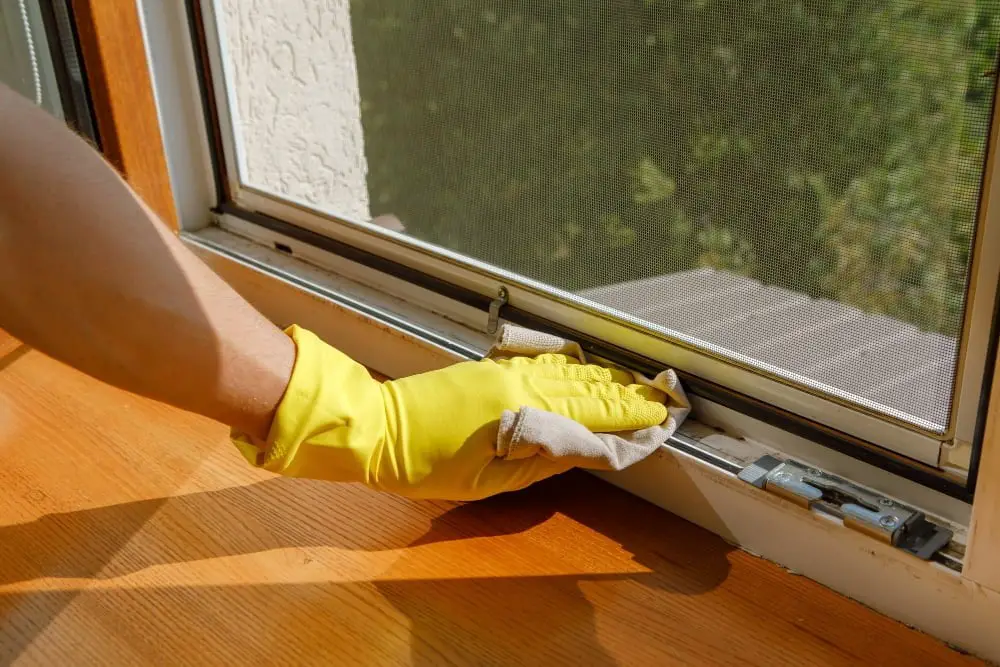
This is especially true if you notice that the mold has spread beyond just your window sills or if there are any signs of structural damage.
Professional services have specialized equipment and expertise needed for thorough cleaning and remediation. They will also conduct an inspection to identify potential sources of moisture that could lead to future growth.
While hiring professionals may cost more than DIY methods, it’s worth considering when dealing with extensive or persistent mold problems. Remember, protecting yourself and your family from harmful health effects should always be a top priority.
Taking care of our homes involves regular maintenance tasks such as cleaning windows regularly. Mold buildup on window sills is not only unsightly but can also pose serious health risks if left untreated for long periods.
By following these tips on how to clean mold off window sills effectively while maintaining safety precautions, we can ensure a cleaner living environment for ourselves and our loved ones!
FAQ
How do you get rid of black mold on window sills?
To get rid of black mold on window sills, generously apply white vinegar using a spray bottle, let it sit for an hour, and then scrub gently with a brush and warm water.
Is bleach or vinegar better to kill mold?
Vinegar is a better option to kill mold as it effectively kills the mold at the root, is less likely to return, and is less toxic than bleach for household use.
Is it normal for mold to grow on window sills?
Yes, it is normal for mold to grow on window sills due to dampness trapped in small crevices and the growth of mold and mildew on wooden substrates.
Why is there black mold on my window sills?
Black mold on window sills is primarily caused by leaks and condensation, often resulting from damaged window frames.
What are the most effective natural remedies for removing mold from window sills?
The most effective natural remedies for removing mold from window sills include using a mixture of vinegar, tea tree oil, or baking soda, along with scrubbing and proper ventilation.
How can I prevent mold growth on window sills in the future?
To prevent mold growth on window sills, ensure proper ventilation, reduce humidity, and routinely clean surfaces to minimize moisture accumulation.
What are the potential health risks associated with mold growing on window sills?
Potential health risks associated with mold growing on window sills include allergies, respiratory issues, and skin irritation.
Recap




